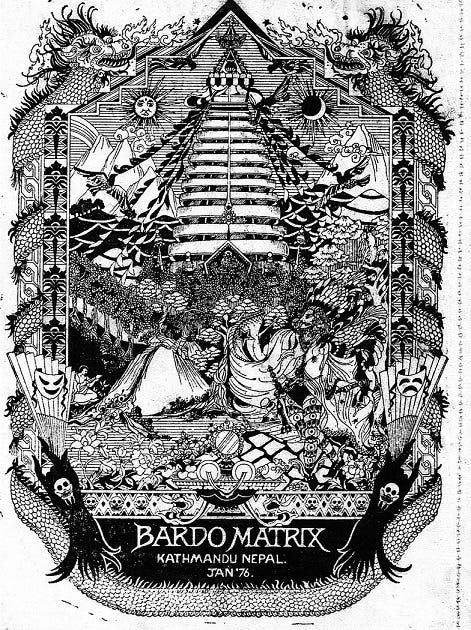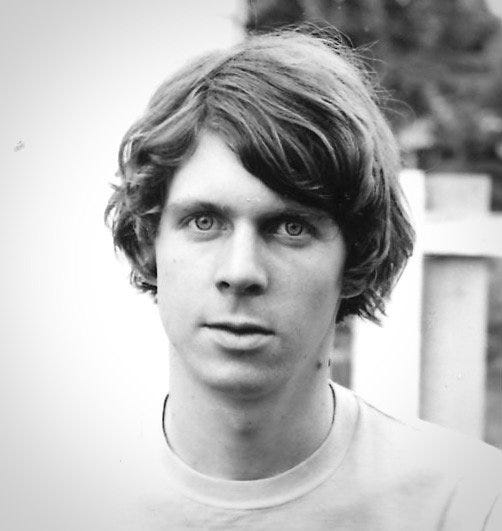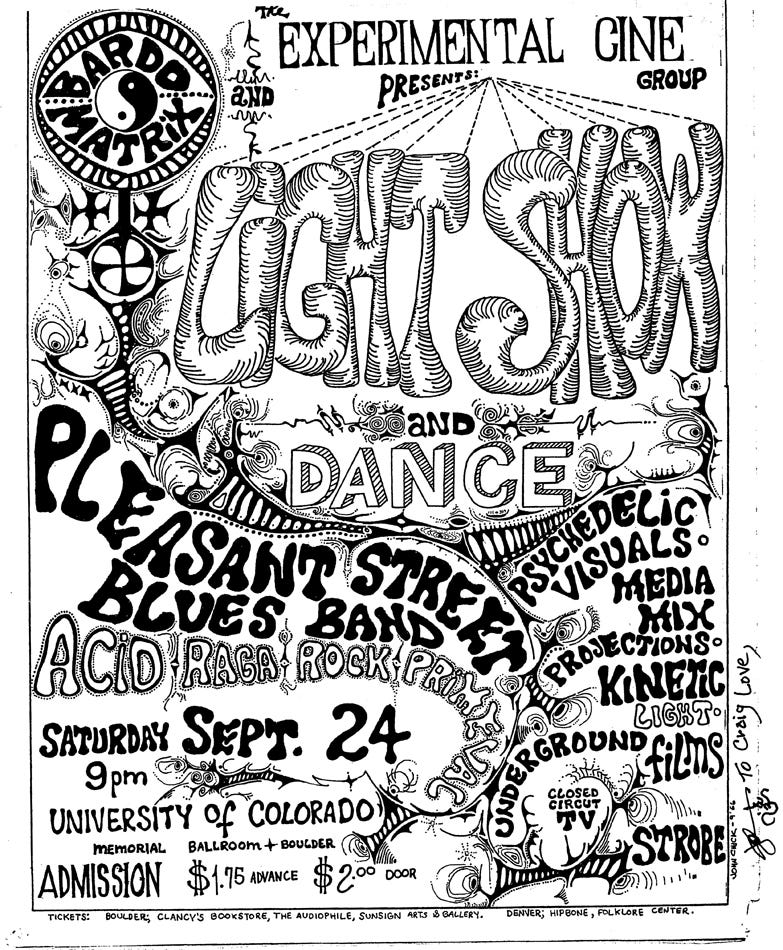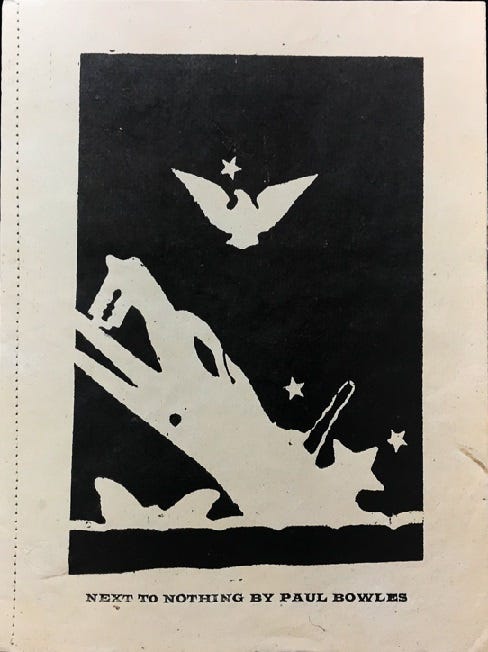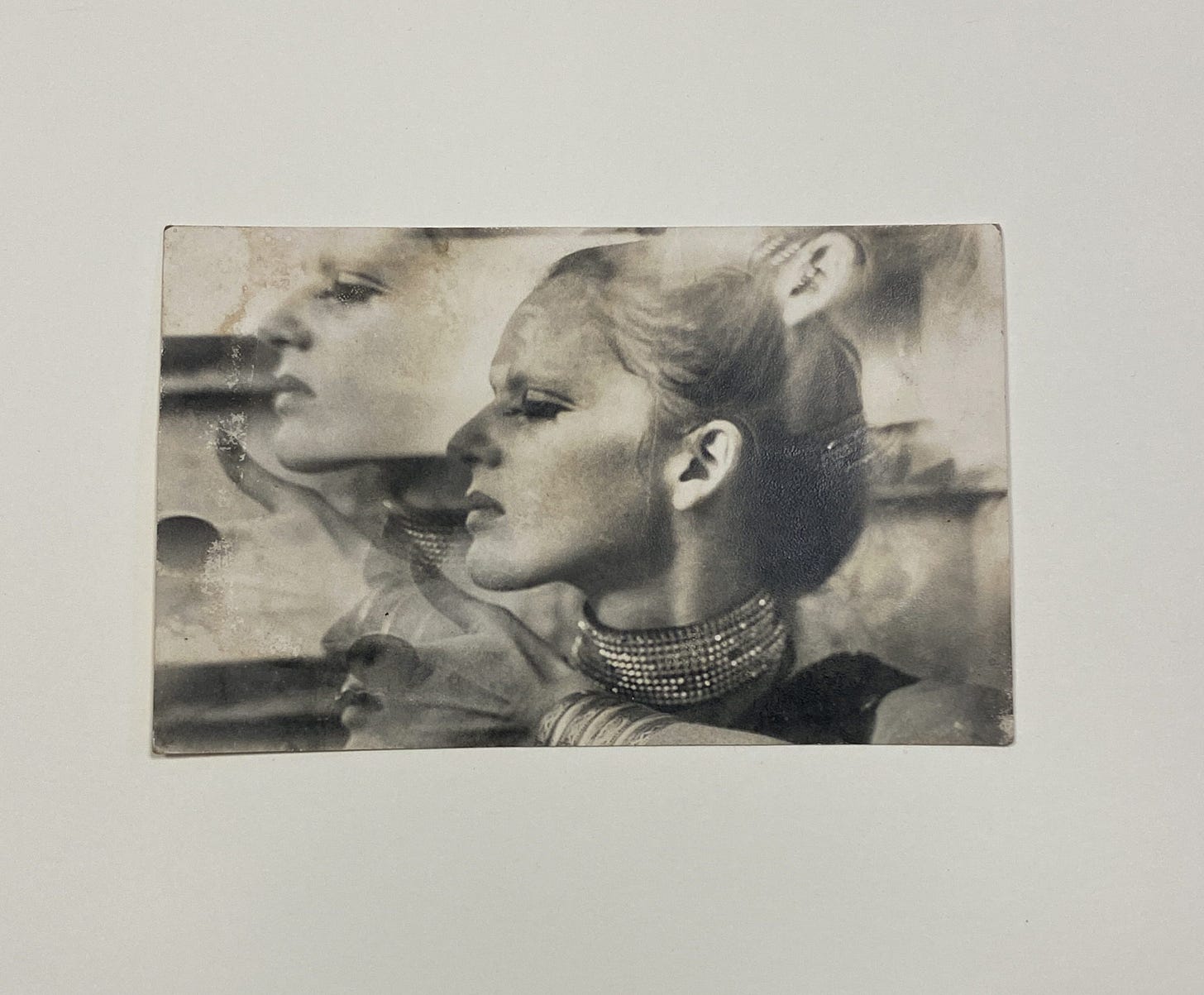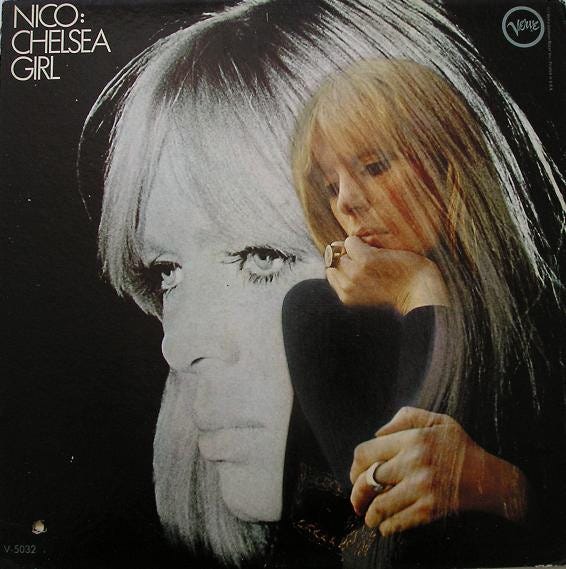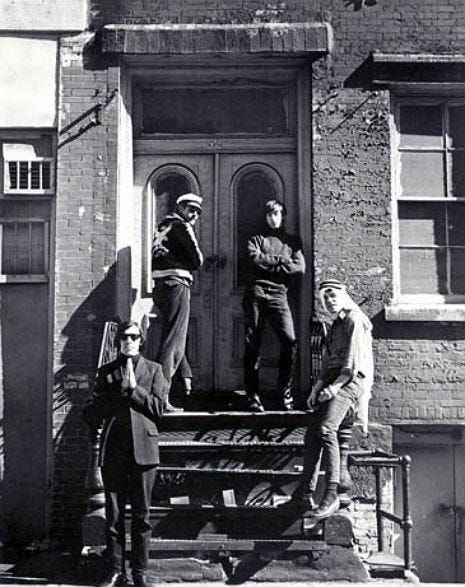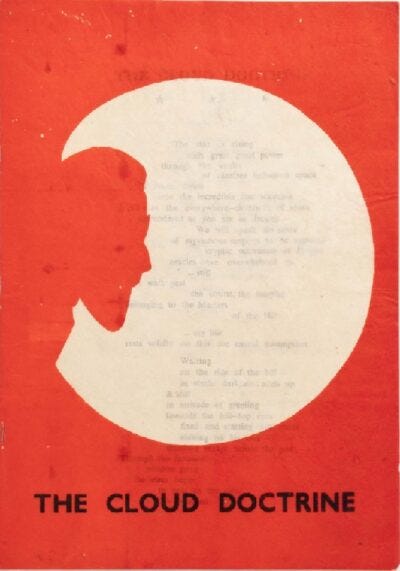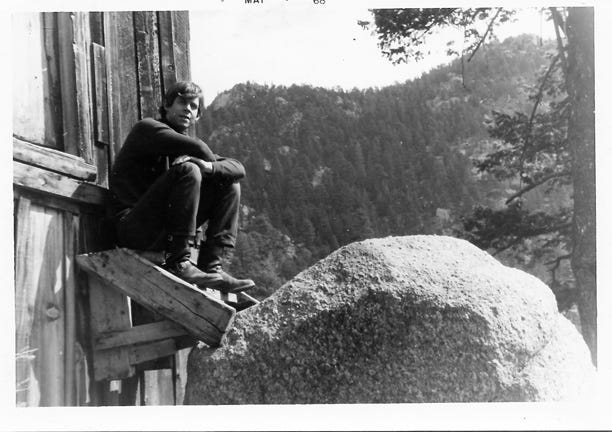Bardo Matrix
Fare Thee Well...
The train leaves at half past ten
But it'll be back in the same old spot again
The conductor
He's still stuck on the line
And if I can save you any time
Come on, give it to me
I'll keep it with mine
-Bob Dylan
Originally, our course was set for Devadip Carlos Santana, but that journey will need to wait a week.
With a heavy heart, I share with you all that on August 8th, 2024, Craig Love passed to The Western Lands.
Craig was an Artist, Filmmaker, Photographer, and a friend. Well, as close as a friend can be who you have never met in person - I think that can be very close. I’m sure many of you can understand that.
In 2019, I sent Craig an email. I was trying to learn more about Bardo Matrix, a 1960s artists’ collective in Boulder, Colorado. He responded with his telephone number and asked me to just call him - he preferred that method of communication rather than the Internet, and so do I. He was a kind man and funny. We spoke many times, and each time he’d try to sell me his photography equipment, but I told him I was no photographer, and they’d be better off in someone else’s hands - literally.
Craig shared stories from his past and sent me some Bardo Matrix ephemera he still had, like unbound woodblock prints from Dana Young’s Opium Elementals, a Starstreams Special Edition published by Bardo Matrix in Kathmandu, Nepal, in 1976. Craig and Dana had been friends since the late 1960s when they lived in Boulder. In The Great Rice Paper Adventure Kathmandu, 1972–1977, poet and photographer Ira Cohen wrote:
Among other books published around the same time was Dana Young’s Opium Elementals in a large horizontal format with an original alphabet designed by the artist who, at my urging, turned one drawing into a series of seven based on traditional Nepali printing blocks intended for textile use. Dana extended the already existing animal figures and other shamanic shapes through his own imagination and created a floating dream world around the central Cocteau-like image of the opium smoker complete with a retinue of skeletons, pumpkins, and ghostly tigers.
At the time of its printing, Young sent a copy of Opium Elementals to historian, author, and Timothy Leary's longtime archivist, Michael Horowitz, who responded to Young in a letter: “To my awe-inspiring surprise to see B[o]ehme quoted [in Opium Elementals].”
Horowitz and his wife, Cynthia Palmer, were “hippie intellectuals.” In 1970, in San Francisco, they co-founded the Fitz Hugh Ludlow Memorial Library, a library of psychoactive drug-related literature. It was named for Fitz Hugh Ludlow, author of the first full-length work of drug literature written by an American, The Hasheesh Eater (1857). The library was the largest of its kind in the world.
In 2003, the Fitz Hugh Ludlow Library was purchased by Colombian-American businessman Julio Mario Santo Domingo Jr. It became part of the Ludlow Santo Domingo Library in Geneva, Switzerland. Throughout his life, Santo Domingo was passionate about literature of all periods but especially French literature of the 19th and 20th centuries. He was a collector of printed books and manuscripts with a particular interest in Marcel Proust, but he also admired and collected the works of Baudelaire, Rimbaud, and Verlaine.
After his death, his family loaned the book collection to the Houghton Library at Harvard University and the music collection to the Rock and Roll Hall of Fame and Museum in Cleveland, Ohio.
Incidentally, Horowitz and Palmer are the parents of Winona Ryder, who was born Winona Laura Horowitz in Winona County, Minnesota. In 1978, when Ryder was seven years old, she and her family relocated to Rainbow, a commune near Elk in Mendocino County, California, where they lived with seven other families on a 300-acre plot of land. When she was ten, the family moved to Petaluma, California. True confession: I have always had a crush on Winona Ryder.
Bardo Matrix was an essential part of the psychedelic expatriate community of poets, musicians, artists, and spiritual seekers in the 1970s. Their publications were printed using techniques like woodblocks, letterpress, special inks, and handmade paper. All were released in small editions of a couple of dozen to a few hundred.
This week on that Big River called Jazz, we’ll dig our paddles in and explore the fascinating world of Bardo Matrix.
The artists who made up the original Bardo Matrix were John Chick, Craig Love, Dana Young, and Greg Sharits, who established The Experimental Cinema group in Boulder, Colorado.
The first printed works of Bardo Matrix are thought to be John Chick’s 1966 Mandalas, which a friend recalls seeing at Clancy’s Bookstore on The Hill in Boulder. Here’s an example of one of Chick’s Mandalas:
The Experimental Cinema group also performed light shows at area concerts. Here’s a poster for a Bardo Matrix event at the University of Colorado in Boulder:
In 1969, Chick decided to travel and moved between London, Paris, and Morocco. In 1970, he arrived in Kathmandu when it had already become an abode of hippie artists, musicians, poets, and writers. Chick and his partner, Regan Heavey, were among the first to arrive there from the original Colorado Bardo Matrix artists. Chick and Angus MacLise opened the Spirit Catcher Bookstore two years later and continued the Bardo Matrix legacy. In the seven years from 1972 to 1979, in a small room in an ancient Jhochhen house, the Spirit Catcher Bookstore was John Chick’s dream. Heavey recalls, “He’d talk a lot about his Boulder days and always harbored a dream of owning a bookstore.” He printed little Indo-Surrealist rice paper flyers at the bookstore for his club, The Rose Mushroom, located at the end of Jhocchen Tole, because of its hippie population known more popularly as "Freak Street."
In 1974, Chick and Ira Cohen published Gregory Corso’s Way Out: A Poem in Discord, the first book in the Bardo Matrix Starstreams Poetry Series.
As a huge fan of Paul Bowles, one day in early 2019, I ran across his Next to Nothing with Dana Young’s print on the frontispiece. It was released in 1976 by Bardo Matrix, which I had never heard of:
It was this book that inspired me to contact Craig Love to learn more about the world of Bardo Matrix.
Next to Nothing was also part of the Starstreams Poetry Series, which included publications by Charles Henri Ford, Diane Di Prima, and Jane Falk. In 1976, Bardo Matrix, in collaboration with Kali Press, published Ira Cohen’s Poems From The Cosmic Crypt, illustrated by Petra Vogt and introduced by Angus MacLise.
Vogt grew up in post-WWII Berlin, where she developed an artistic and spiritual flair in a world surrounded by violence, transnational movement, and creative experimentation that marked our contemporary understanding of the twentieth century. In 1962, Vogt moved to New York City and joined The Living Theatre, an experimental theatre company. While touring the United States with the company for their performance of Paradise Now, she met Ira Cohen.
In the early 1970s, Vogt immigrated with Cohen to Nepal, where they met other creatives, wanderers, and notable visitors to “Freak Street.” Here’s a mylar photograph by Ira Cohen of Petra Vogt, ca. 1970-1979:
Petra Vogt has always reminded me of another German bombshell, Nico. I think the physical resemblance comes out on the cover of Chelsea Girl, her debut solo album released in October 1967 by Verve Records:
The title refers to Andy Warhol's 1966 film Chelsea Girls, in which Nico starred.
Jackson Browne wrote three songs on the album. On his song Somewhere There's a Feather, he plays guitar while Nico sings:
Although she only made two albums with The Velvet Underground - their iconic debut, The Velvet Underground & Nico, and Chelsea Girl, on which they provide some accompaniment - most people identify Nico with them. That’s a shame because she was so much more than that and an amazing artist in her own right - we’ll explore her world a little further down the river…
Speaking of The Velvet Underground, another brief but important artist in the group was Angus MacLise.
Here’s a 1965 photo of The Velvet Underground on Ludlow Street, one of the earliest known pictures with Angus MacLise (top left) with the Underground’s Sterling Morrison (top right), John Cale (front left), and Lou Reed (in keffiyeh):
Angus MacLise was born in Bridgeport, Connecticut, in 1938. He studied music and dance before moving to Paris in the late 1950s. In Paris, he and his high school friend, avant-garde filmmaker Piero Heliczer, started the Dead Language Press in 1958. MacLise later moved to Berkeley, California, where he met Hetty McGee. They were married in a ceremony at Golden Gate Park in San Francisco.
In 1970, the couple toured Asia and finally settled in Kathmandu, where they helped operate the Spirit Catcher Bookshop. In 1974, MacLise and Ira Cohen started the Bardo Matrix publishing venture.
Again, from The Great Rice Paper Adventure Kathmandu, 1972-1977, Ira Cohen wrote:
Angus had always been interested in innovative printing, and working with Piero Heliczer on the Dead Language Press making unique books from treebark or fashioning long horizontal handmade books after the Tibetan or Indian style. It was Angus who, working with local craftsmen and woodblock artists, really began the great rice paper adventure.
Their first book was MacLise’s 1974 The Cloud Doctrine:
The Cloud Doctrine set the template and defined the Bardo Matrix style. Unfortunately, MacLise died in 1979 in Kathmandu. He was only 41. After his death, the activity of the Bardo Matrix press quietly faded away.
Here’s one more for the road. I love Nico’s cover of Jackson Browne’s These Days:
I’ll listen to this song and think about Craig Love, who took the time to introduce me to Bardo Matrix. Here he is, counting the quarter tones:
And then, of course, there’s Nico. Every time I hear her sing These days, and her voice trembles at “so long,” my heart skips a beat. And I think the song’s last line hits home for her: “Don't confront me with my failures. I had not forgotten them.” She came far, and I always wonder if she thought it was worth the trouble.
Bardo Matrix came far too. It was an amazing journey. With Love’s passing, it marks the end of an era.
Fare thee well, Craig Love, the last of the original Bardo Matrix crew.
Next week on that Big River called Jazz, we’ll get back on track and dig our paddles into the waters of Devadip Carlos Santana.
Please hit this link to buy me a cup of coffee, if you’d like to show your guide some appreciation for this and past journeys. Know in advance that I thank you for your kindness and support.
If you like what you’ve been reading and hearing so far on our journey and would like to share this with someone you think might be interested in learning more about our great American art form: Jazz, just hit the “Share” button.
From Astaire to Sun Ra: A Jazz Journey is a reader-supported publication. If you feel so inclined, subscribe to my journey by hitting the “Subscribe now” button.
Also, find my playlist on Spotify: From Fred Astaire to Sun Ra.
Feel free to contact me at any time to talk shop. I welcome and encourage that.
Until then, keep on walking….


